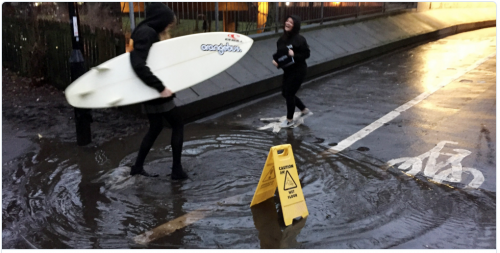What was originally set up as a way to amuse their own staff the Drummond Central live feed of passers-by trying to circumnavigate a puddle became an internet sensation for the day.
Flooding across the internet to gain over 50,000 interactions on twitter and with more than 500,000 viewers watching the live stream on Periscope it certainly provided the medium to get a big footprint.
The #DrummondPuddleWatch Periscope has captured the world’s attention; over 50K Tweets. https://t.co/PyENbIq2Hb pic.twitter.com/si7ah7z8Pu
— Twitter Data (@TwitterData) January 6, 2016
With this accelerated interest companies couldn’t help resist, alike the pun, ‘jumping in’ on the action and using guerrilla ambush marketing tactics for self promotion. Some, like innocent, latched onto the hashtag to draw attention via themselves with others using clever references as a way to promote their own products.
3000 people are watching a puddle in Newcastle. Great Britain at its finest #DrummondPuddleWatch https://t.co/SslNEpwurK
— innocent drinks (@innocent) January 6, 2016
We can end this here. #DrummondPuddleWatch ?
— Bounty (@Bounty) January 6, 2016
Now THIS is how you cross a puddle. #DrummondPuddleWatch pic.twitter.com/rHRivt0cCP
— DiRT (@dirtgame) January 6, 2016
This technique has unsurprisingly been seen before, with a notable mention to the effective and masterfully done #StopAbuseAgainstWomen campaign which drew tens of thousands of interactions through riding off the back of the ever so controversial Black and Blue dress… or was it White and Gold?
It met almost all the criteria of what Dobele, Toleman & Beverland (2005) call an ‘engaging message’ (which are more likely to be voluntarily shared) by capturing the imagination of viewers through being intriguing and utilising a product of high visibility.
Why is it so hard to see black and blue? One in 6 women are victims of abuse. #StopAbuseAgainstWomen pic.twitter.com/FgDdKdsMMb
— TheSalvationArmySA (@SalvationArmySA) March 6, 2015
The most successful company creating waves with the puddle, in my opinion, was Orange Bus. Berger & Milkman’s (2012) study shows that content that evokes arousal, such as amusement, is more likely to be shared. After one ‘attention seeker’ brought his lilo down who was to suspect a surfboard would have an ulterior motive. Unlike many others whose wake stopped at twitter they oh so stealthy slipped into being the face of the puddle in multiple national newspapers and even BBC news.
However, it’s not all success stories. Some tried to get their feet wet but took an almighty plunge in doing so. Higgidy, even though boasting 10.6K followers, only managed to rack up 2 likes on their attempt to free ride.
I think we need a bigger boat. #DrummondPuddleWatchpic.twitter.com/9nDfgrET89
— Higgidy (@higgidy) January 6, 2016
There’s no doubt that there was an amusing concept behind Higgidy’s content but what caused it to receive no recognition? Aula (2010) finds that companies run risk to their reputation if they do not meet the expectations of consumers. With Higgidy being a premium product you would expect the content they produce on social media to be of the same quality they produce from their ovens. In this case, using what would seem like MS paint to knock up a last minute attempt doesn’t quite cut the quiche for a nationwide company.
Higgidy has taught us not to cheap out on image from Dodaro’s (2013) first easy steps to destroying your reputation online, so what else do we need to consider when attempting to get some painless publicity?
Jumping onto a trend or event by having some form of input (direct or indirect) is going to get you seen, but not always in good light. Habitat destroyed themselves after attempting ride on the back of protests and conflict in Iran. On the other hand, Ann Summers play on words in their paid search campaign mastered this all the way down to how they described it –
“The strategy was not to deliver clicks – it was toleverage the paid search mechanic to cheekily insert the Ann Summers brand into unusual places“.
Another great example of using real world events with a play on words is Pieminister’s – Black ‘Pie’ Day. Though not gaining the mass of publicity off the original trend, after seeing it and combining it with the anti-consumerism message, it provides a psychological connection to recall it every year.
Free pies tomorrow from 8am in exchange for donations to @shelter #blackpieday #wastenot #stokescroft pic.twitter.com/2nBjOgUvlW
— pieminister (@pieminister) November 26, 2015
What we take away from this is the reminder that the content has to fit, be that time, place and delivery as well as invoke some form of emotional response to engage the user. Events used properly can provide countless free attention but not doing your research or implementing an idea properly can lead to a stumble that you may not be able to pick yourself up from.
Aula, P. (2010). Social media, reputation risk and ambient publicity management. Strategy & Leadership. Vol. 38, No. 6, pp. 43-49.
Berger, J. & Milkman, K.L. (2012). What Makes Online Content Viral? Journal of Marketing Research. Vol. 49, No. 2, pp. 192-205.
Dobele, A., Toleman, D. & Beverland, M. (2005) Controlled infection! Spreading the brand message through viral marketing. Business Horizons. Vol. 48, No. 2, pp. 143-149.
Dodaro, M. (2013). 10 Business-Killing Social Media Mistakes. [Online] Available at: <http://topdogsocialmedia.com/social-media-reputation-management-mistakes/> [Accessed 25th January 2015].
